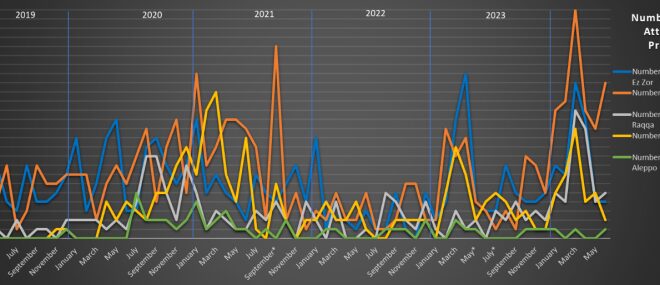ISIS carried out at least 29 confirmed attacks in June in the Homs, Hama, Raqqa, Deir Ez Zor, and Aleppo governorates. These attacks killed at least 49 pro-Assad regime soldiers and two civilians and wounded at least 23 more soldiers and civilians. There were also 12 high quality* attacks carried out during the month. The level of violence increased in June by every metric compared to May. However, most of these attacks occurred in the first half of the month amid a series of regime military operations in eastern Homs. As in May, there were relatively few attacks in Deir Ez Zor and Hama, as Homs remained the center of ISIS activity in the Badia.
Civilians once again came under attack in June from ISIS. Several brutal attacks were carried out against local tribesmen in the Jubb Jarah region of eastern Homs that resulted in locals hunting down and killing two ISIS members. Still, the vast majority of ISIS activity remained focused on security forces. More “aggressive” attacks – using small and medium arms to ambush patrols and fixed positions were more frequent than those relying on mine fields. June also witnessed the most severe leadership losses for the regime in years, with three senior officers killed in eastern Homs and one local commander wounded in Deir Ez Zor. Nevertheless, regime security forces appear to have successfully established new defensive positions around several critical areas in Homs, particularly the Doubayat and Kawm axes, which have for now reduced ISIS activity along these fronts.
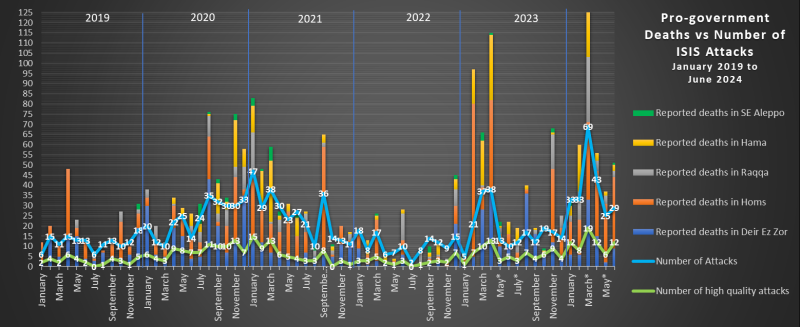
Confirmed ISIS attacks increased in Homs (17) and Raqqa (5), remained steady in Deir Ez Zor (4) and dropped in Hama (2). There was also one recorded attack in southern Aleppo in June, the first such attack since March.
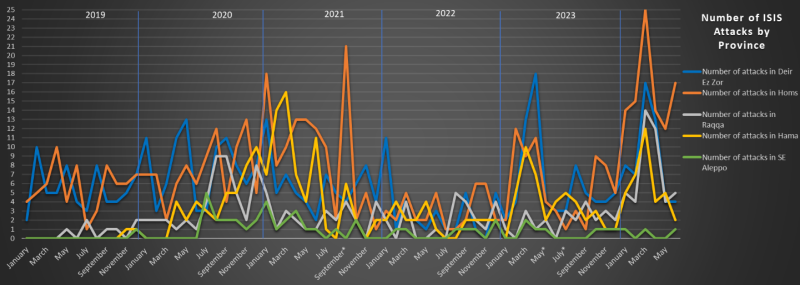
Deir Ez Zor and Raqqa
ISIS expanded its low-level insurgency within the urban belt of Deir Ez Zor in January, when it conducted three assassinations of local security forces. Sleeper cells continued this trend in February, carrying out two assassinations of local pro-regime fighters inside Mayadin city, and again in March, when unidentified gunmen conducted three attacks inside Mayadin and one attack on the edge of Shamitiyah. This pattern continued into April, with one attack inside Mayadin and two attacks within and adjacent to towns in west Deir Ez Zor. In May, regime security forces captured a small four-man ISIS cell inside Mayadin. According to local journalist Zain al-Abidin, three of the detained men were serving in the pro-regime National Defense Forces (NDF) and their leader had entered Mayadin from northeast Syria during the regime’s 2022 reconciliation initiative – a security risk this author had highlighted at the time. There were no recorded attacks in Mayadin in June, however, there was an IED attack inside Deir Ez Zor city and a small arms attack inside Shamitiyah.
On June 8, two members of the Russian and Syrian Republican Guard-backed tribal militia “Usoud Sharqiyeh Shaitat” were killed by an improvised explosive device (IED) while driving inside Deir Ez Zor city. The next day, gunmen stormed a 4th Division security point adjacent to Shamitiyah’s Municipality Building, killing three soldiers and wounding a fourth. No one has claimed responsibility for this attack. Local journalist Zain al-Abidin believes the attack may be linked to a growing feud between the 4th Division and members of the Busraya tribe, as the two sides compete over control of smuggling routes in the area.
On June 14, a small group of Iranian-backed tribal fighters were ambushed while driving on a remote road from the Mu’ayzilah hamlet in central southwest Deir Ez Zor to the city of Salihiyah. Three militia fighters were killed and five wounded, including the commander of the Salihiyah Sector Khalaf al-Zarzour. On June 18, a 1st Lieutenant serving as an engineer in the army was killed in an attack on the Kharata Oil Field outside Deir Ez Zor. The next day, Russian state media claimed to have conducted a drone strike on ISIS militants attempting to attack the field.
In Raqqa, ISIS activity dropped back down to more typical levels in May following two months of extreme activity. Since then, the group has maintained a low-level but robust insurgency focused in the desert between Resafa and Jabal Bishri. On June 9, a soldier from the 25th Division was killed by a mine in the desert east of Resafa. On June 12, two more soldiers were reported killed somewhere in the same region. On June 26, ISIS militants launched a rare anti-tank guided missile (ATGM) attack on a regime vehicle on the western side of Jabal Bishri, wounding two soldiers. This is the third such attack in the Badia this year. On June 29, ISIS claimed responsibility for an assassination of a 17th Division soldier in his hometown of Ghanem Ali. ISIS conducted a similar assassination in nearby Maadan on March 2 of this year.
Meanwhile, regime security forces led by Major General Suhail Hassan initiated new operations in the southern Raqqa desert in the second half of June. According to Zain al-Abidin’s sources in the area, these patrols found and clashed with an ISIS cell on June 26 west of Jabal Bishri, killing two ISIS fighters and uncovering a large cave used as a base of operations.
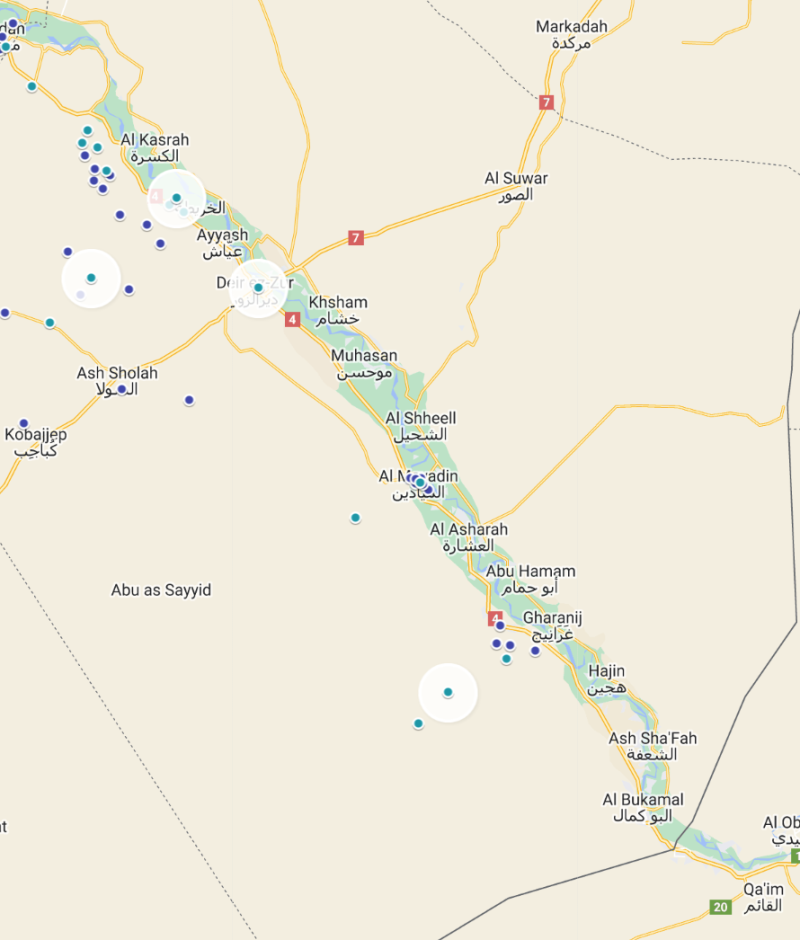
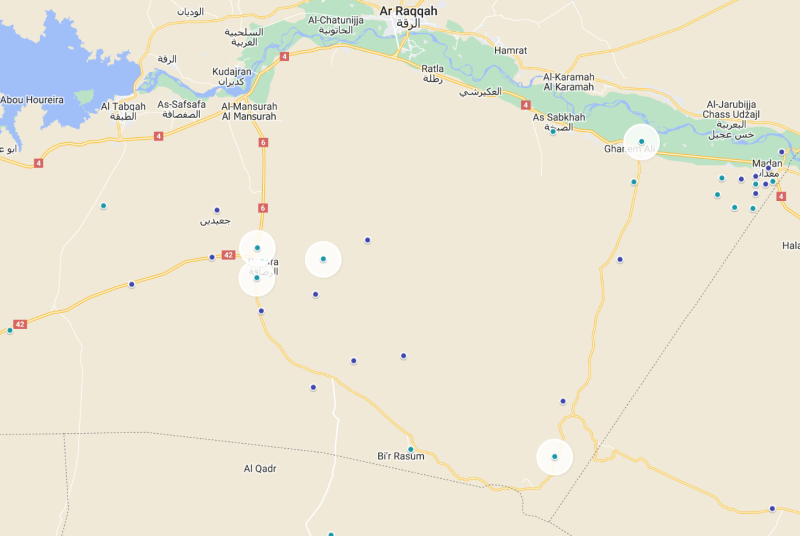
Homs
ISIS activity in eastern Homs decreased in December, but remained focused around the Doubayat Oil Field, which the group had temporarily captured in November. January likewise saw most ISIS activity concentrated in this area, though the group also expanded operations west into the desert just south of Palmyra and Arak. In February, ISIS largely abandoned the southern Palmyra front, likely because of pro-regime ground and air operations, and shifted its focus to the Taybeh sector north of Sukhnah and the Jubb Jarah mountains north of Palmyra. This focus continued into March, with activity remaining concentrated in the Sukhnah-Taybeh-Kawm axis in both April and May. However, security forces continued to largely stand their ground and June saw ISIS once again shift its attacks to the Jubb Jarah and southern Wadi Doubayat-Palmyra region, seemingly abandoning the Taybeh-Kawm front, at least temporarily.
On June 4, ISIS militants attacked a barracks in the Abbasiyah area south of Palmyra, killing two soldiers and wounding one. On June 5, local Facebook pages reported at least two soldiers who went missing from their post in the Jabal Amour area north of Palmyra. The next day, ISIS militants attacked a group of shepherds and their guards near Abu Aylah in the Jubb Jarah region, killing four guards, two shepherds and stealing 1,000 or more sheep. The next day, locals from the Bani Khalid tribe – whose shepherds and truffle hunters have regularly been attacked by ISIS – found and killed two of the ISIS fighters responsible for the attack. The militants were discovered near the village of Jabab Hamad. On June 7, three Liwa al-Quds fighters were killed in an ISIS ambush in the Jabal Amour region.
On June 8, ISIS conducted another attack between Abu Aylah and Jabab Hamad, this time killing three 11th Division soldiers at their position. A fourth soldier was reported killed near the T4 Airbase, south of Jub Jarah, and a fifth soldier was reported killed in the southeastern Homs countryside that same day. On June 11, a shepherd was killed by a mine near Qaryatayn. It is not clear who placed the mine, however, it is worth noting the event since several years ago, ISIS made inroads into this region. That same day, two soldiers were reported killed in an unspecified part of eastern Homs, likely near Wadi Doubayat during the 25th Division’s new operation there.
On June 12, a 25th Division convoy combing the southern side of the field fell into an ISIS minefield and small arms ambush. More than a dozen soldiers were reportedly trapped, their ultimate fate unclear. However, martyrdom announcements were released for a brigadier general and a colonel who were killed when their vehicle hit one of the mines, as well as for at least two other soldiers killed in the battle. That same day, three other soldiers were reported killed and two wounded in another ISIS attack near Jabab Hamad.
On June 13, a soldier was reported killed in an unspecified part of eastern Homs, again likely to be Wadi Doubayat. On June 15, ISIS members launched a retaliatory attack against Bani Khalid tribesmen in the Jubb Jarah region, overrunning a temporary camp used by shepherds. Three men were injured, hundreds of sheep were killed, and two trucks and tents burned down. On June 18, a lieutenant colonel was killed in the Talilah Reserve area south of Palmyra, the third high ranking officer killed in June. On June 24, a captain was reported killed near Palmyra. On June 30, four more soldiers were killed when their position in Jubb Jarah came under attack from ISIS militants.
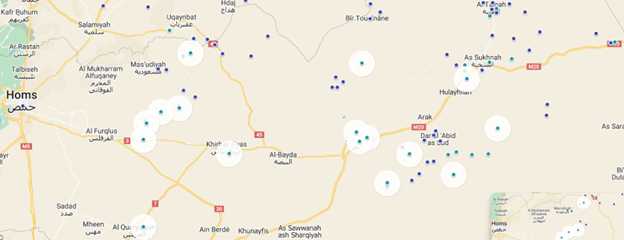
Hama
Significant ISIS activity returned to east Hama in January, when the group conducted five attacks in the province, three of which were high quality. Likewise, ISIS conducted three high quality attacks in eastern Hama in February. This was the first time eastern Hama had back-to-back months of three or more high quality attacks since spring of 2021. In March, there were five high quality and 12 total attacks, almost all against security forces. However, activity fell significantly in April and May, and even further in June, which had only two documented attacks.
On June 10, two soldiers were killed and four were wounded when their vehicle hit a mine around 30km east of Ithriyah on the road to Raqqa. Similarly, on June 20, one soldier was killed and four were wounded by a mine east of Ithriyah.
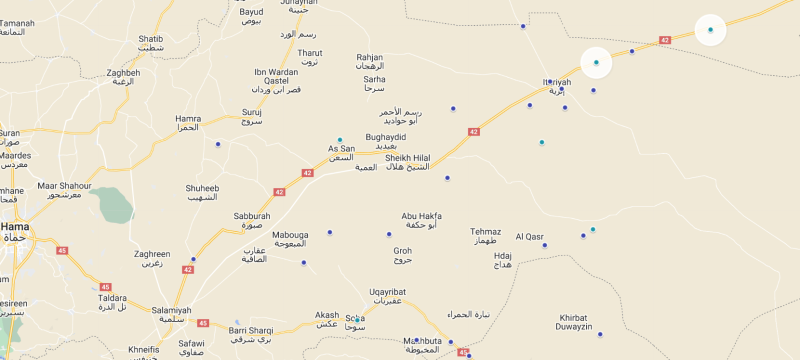
Looking Ahead
The 4th Division’s “Ghaith Forces” arrived in Deir Ez Zor in early March, tasked with securing the eastern half of the Palmyra-Deir Ez Zor road from increasing ISIS attacks. Since late April, ISIS attacks in Deir Ez Zor have decreased significantly – either a direct result of the new operations or because of resource demands elsewhere. However, this was the first deployment of serious front-line units to central Syria as part of the military’s counter-insurgency campaign. Unlike other 4th Division units sent to the Badia since early 2021, the Ghaith Forces have a long history as key storming units in many of the sieges in and around Damascus and Dara’a. Their commander, Brigadier General Ghaith Dalah, was even appointed deputy commander of the entire 4th Division in late June.
Perhaps hoping to mimic this success, the regime and the Russian command then sent the 25th Division to eastern Homs in early June, marking the second front-line unit dedicated to the anti-ISIS fight. The 25th Division – formerly the Tiger Forces – have been among the most important military units operating in northwest Syria. In its original iteration, the Tiger Forces were crucial for mobilizing loyalist communities across northern Hama to form a dual auxiliary-storming type force that could both reliably hold down front-line towns and conduct serious storming operations across the country. Much of their fighting prowess stemmed from the close relationship the unit had with both the Russian Air Force and Army officers (who regularly provided logistical, command, artillery, and air support to the Tigers) and their privileged position within the regime’s security hierarchy, which gave them priority access to air and armor assets. The Tigers, alongside the Russian-commanded Syrian 5th Corps, were central components of the regime’s last major northwest Syria campaign. That operation ended in February 2020 with a Russia-Turkey ceasefire, after which the 25th Division maintained its presence around northwest Syria and expanded recruitment and training.
The June Badia deployment marks the first true combat deployment for the 25th Division since February 2020. Elements of the 25th Division have, for several years, helped patrol and secure the Khanasir-Ithriya axis from ISIS attacks. But the units deployed here are part of the new cohort, the army recruits that have been brought into the division after its transformation. The east Homs deployment is unique in that it involves many of the core, veteran Tiger Forces units – the men that have led and would be expected to lead any future Idlib offensive. The difference in scope of this new deployment from the Ithriya operations can clearly be seen in the severity of the losses the division has suffered this month. These new units – alongside regular Syrian Arab Army (SAA) divisions and auxiliaries like Liwa al-Quds and the al-Assad Shield Forces, conducted patrols across northeast and southeast Homs in June. According to Zain al-Abidin: “regime forces penetrated 1 km south of Doubayat and combed the perimeter of Tuwaynan, Wadi al-Abyad Dam, and parts of the Amour Mountains. They added new defensive lines around the towns of Koum, Taybeh, and Kadir and established a permanent military point near Bir Barbar north of Kadir. They also established new points around the Arak field, which witnessed significant activity by ISIS groups in its vicinity last May.”
All of this is to say that, for the first time since ISIS began its insurgency, there is a clear broader impact on the regime’s military capabilities. ISIS’s previously unseen levels of sustained operations this year has already forced the Russian Air Force to operate at an equally unseen sustained level across central Syria. Now Damascus has not only deployed core 4th Division units (the same men who had led May operations in southwestern Syria) but also its primary northwestern Syria storming unit.
This does not mean that the Idlib frontline has been weakened in any serious way – the regime still maintains a robust number of regular army units there from Latakia to west Aleppo. Rather, it is a potential sign of the level of disruption ISIS’s insurgency can impose on broader regime plans in the future. Should the northwest ceasefire collapse or the Americans withdraw from northeast Syria, the regime and Russia will undoubtedly initiate full-scale operations in these regions – operations which would require assets now committed to central Syria. Should ISIS continue to pose the current level of threat in central Syria into the future, both Russia and the Syrian regime may be forced to make concessions on one front.
It is thanks to these deployments and dedicated airpower that the regime’s security forces have been able to make the inroads they have in the last two weeks of June. These operations and the heavy ground and air presence across eastern Homs have, so far, seemed to slow down ISIS’s operations. It remains to be seen how long these units will remain in central Syria. The regime and Russia’s approach this spring has begun to mirror that of January 2020, when the regime flooded central Syria with soldiers to dampen ISIS activity. Back then, however, the deployments gradually ended, as did Russia’s persistent air activity, giving room for ISIS’s return. It remains to be seen whether the regime or Russia is prepared to dedicate the current level of resources in central Syria for the long run.
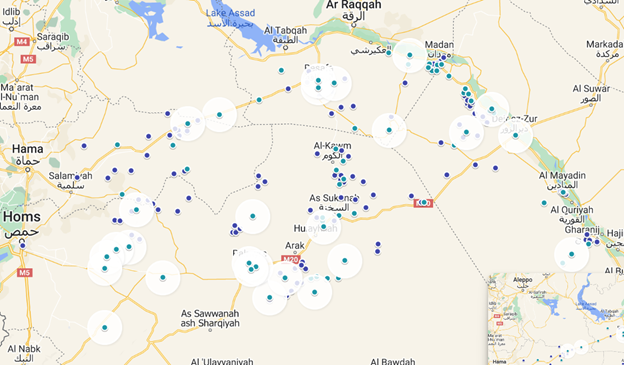
*High quality attacks are defined as attacks behind frontlines, attacks that result in seized positions, target regime officers, or involve coordinated attacks on multiple positions, “flying checkpoints” (temporary roadblocks ISIS fighters establish in order to stop and extort or ambush a few cars), ambushes on military convoys, or attacks on checkpoints that kill at least three soldiers or lead to POWs.
 Eurasia Press & News
Eurasia Press & News
